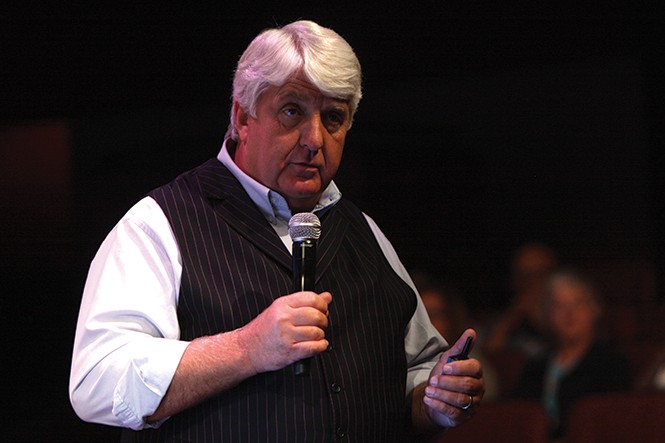Bishop's Pawn
A federal-lands program had broad support until Utah Congressman Rob Bishop gave it the ax
By Eric Ethington @ericethingtonVery quietly, one of the few federal conservation programs that enjoyed wide bipartisan support in Congress and among the public was allowed to expire at the end of September, 2015. No public vote was taken. Instead, the chairman of the House Natural Resources Committee—a man with a long history of opposing conservation efforts—refused to allow the program to be considered for renewal. That chairman was the Republican Congressman for Utah's 1st district, Rob Bishop.
The Land & Water Conservation Fund (LWCF) was started by Congress 50 years ago with a simple goal in mind: to use the money oil and gas companies pay for offshore drilling permits to protect public lands and expand opportunities for recreation and conservation.
When most national parks, forests and other public lands were first created, most of their boundaries included both public and private land. So while Zion National Park, for example, encompasses 229 square miles in area, some of the land within its boundaries is privately owned and inaccessible to the public. Whenever such parcels go up for sale, LWCF funds are used to purchase them—ensuring coal mines and lumber mills don't end up in the midst of hiking trails, hunting areas and fisheries.
Additionally, LWCF grants are given to states and local communities to use in the creation and maintenance of state parks, as well as community parks such as picnic areas and baseball fields.
Bishop declined to be interviewed for this story. But his spokeswoman, press secretary for Natural Resources Julia Slingsby, said the bill needs to be reformed. "Chairman Bishop believes that the Land & Water Conservation Fund has strayed away from its original intent," says Slingsby. "In the beginning, there was 60 percent of the funds that were going to state and local projects, and going to [states] so they could best allocate what to do with those resources.
"Now that number is down to 16 percent," Slingsby says. "So the feds are using more and more of those funds to buy up lands, and Chairman Bishop is opposed to that, because the federal government cannot even take care of the lands that it has."
But according to advocates for the 1965 law, not only do states and local governments frequently take advantage of the program to fund local projects, federal agencies like the U.S. Forest Service rely on it to patch up the holes in national parks and forests so that they can better be maintained. Leaving large patches of private lands within national parks and forests hinders efforts by the National Park Service and the U.S. Forest Service to fight fires and protect the land.
According to National Park Service reports, more than 450 projects in almost every county in Utah were created with the help of $48 million from LWCF funding—including golf courses, baseball diamonds and parks such as Murray Park and Sugar House Park. The state's forests have benefited as well, says U.S. Forest Service Legislative Affairs Coordinator Wade Muehlhof, who added, "Going back 20 years in Utah, there are roughly 20,213 acres that the Forest Service has acquired since 1995 using LWCF-appropriated funds." Muehlhof says those acres were purchased with more than $34.5 million in LWCF funds collected from offshore drilling.
One of the LWCF's biggest local success stories, says Muehlhof, is the 1,790-acre Orderville Gulch property located between Zion National Park and the Orderville Canyon Wilderness Study Area. "The property serves as the popular alternate route to the stunning Zion Narrows hike," Muehlhof says. The sandstone Orderville and Birch slot canyons attract more than 20,000 climbing and canyoneering enthusiasts from around the world, contributing more than $3 million to the local economy.
Without the LWCF funds, Muehlhof says, privately owned land such as Orderville Gulch could have gone to energy-development companies or just other private buyers—either of whom might immediately have put up fences and denied public access to those trails.
LWCF monies have been responsible for the creation and development of parks in all 50 states, including Grand Canyon National Park and the Great Smoky Mountains National Park, as well as the preservation of 19 different Civil War battlefields and more than two-thirds of the Appalachian National Scenic Trail—all without the use of tax dollars.
Despite this, Bishop maintains that "the status quo needs to be challenged," says Swingsby. "He wants to update the law."
The LWCF's expiration puts at risk many different ongoing projects in various states, Muehlhof says. In Utah, for example, the Forest Service is working to purchase roughly 858 acres in Mill Creek Canyon from Boy Scouts of America. The purchase is supported by state, county and local governments, and contains portions of the Bonneville Shoreline Trail on its western side. It also would provide trail access to the Mount Olympus Wilderness area in its easterly portion.
Muehlhof says the Forest Service wants to purchase the land in order to increase management efficiency and provide access to critical in-holdings such as Pipeline Bike Trail, Rattlesnake Gulch Trail, Thayne Canyon Trailhead, and the Church Fork and Box Elder picnic areas. The end of the LWCF may have consequences that are difficult to predict, says Muehlhof.
Bishop's spokesperson is skeptical that current projects would be interrupted much. "There are still funds in the program," says Slingsby, in reference to moneys that have not yet been used. "But we want to take our time to make reforms to the law ... and empower states, and not use it for federal land acquisition."
However, any new parks or projects by Utah or local cities could be put on hold until the program is renewed.
There have been three bipartisan bills introduced in Congress to reauthorize the LWCF, including some that would make the reauthorization permanent and keep royalties from oil and gas companies flowing into communities adjacent to national parks and forests. However, before any such bill could receive a vote, it would need the support of the House Natural Resources Committee, which Bishop chairs. For a bill to get to that point, Bishop would need to allow it to be heard and discussed in committee.
Bishop's spokesperson said she expects to see Bishop introduce a reform bill within the next four to six weeks. "Congress is not meant to just keep reauthorizing [laws]," says Slingsby. "If it's not working the way we need it to be, then we let it expire, and we'll be reforming it this fall."
More by Eric Ethington
-
The Challengers
Two Democrats square off to take on Sen. Mike Lee
- May 4, 2016
-
Prison 'Skype' Replaces Visitation
Uintah County Jail enforces new video-chat program.
- Apr 27, 2016
-
Boat Rockers
Democratic Party struggles to bridge gap between Sanders supporters and the establishment.
- Apr 13, 2016
- More »
Latest in News
Readers also liked…
-
Raise a glass for E.L.T Harrison, architect of the Beerhive building on Main
Small Lake City
- Oct 11, 2023





